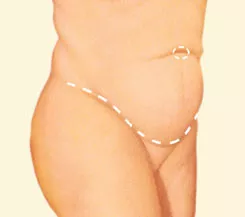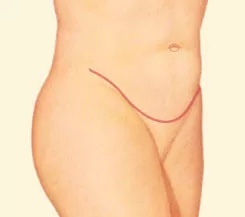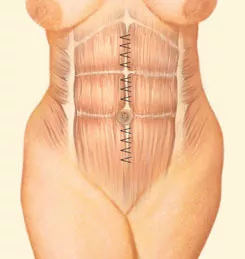Abdominoplasty, known more commonly as a tummy tuck, is a major surgical procedure to remove excess skin and fat from the middle and lower abdomen and to tighten the muscles of the abdominal wall.

The procedure can dramatically reduce the appearance of a protruding abdomen. But bear in mind, it does produce a permanent scar, which, depending on the extent of the original problem and the surgery required to correct it, can extend from hip to hip as demonstrated in the image above.
The best candidates for abdominoplasty
The best candidates for abdominoplasty are men or women who are in relatively good shape but are bothered by loose abdominal skin and fat that won’t respond to diet or exercise. The surgery is particularly helpful to women who, through pregnancies, have stretched their abdominal muscles and skin beyond the point where they can return to normal. Loss of skin elasticity in older patients, which frequently occurs with slight obesity, can also be improved.
Patients who intend to lose a lot of weight should postpone the surgery. Also, women who plan future pregnancies should generally wait, as vertical muscles in the abdomen that are tightened during surgery can separate again during pregnancy. If you have scarring from previous abdominal surgery, your doctor may recommend against abdominoplasty or may caution you that the results of the procedure could be compromised.
Abdominoplasty can enhance your appearance and your self-confidence, but it won’t necessarily change your looks to match your ideal, or cause other people to treat you differently. Before you decide to have surgery, think carefully about your expectations and discuss them with your surgeon.
Planning your surgery

In your initial consultation, your surgeon will evaluate your health, determine the extent of fat deposits in your abdominal region, and carefully assess your skin tone. Be sure to tell your surgeon if you smoke, and if you’re taking any medications, vitamins, or other drugs.
Be frank in discussing your expectations with your surgeon. He or she should be equally frank with you, describing your alternatives and the risks and limitations of each.
A standard abdominoplasty involving a transverse lower abdominal incision, repositioning of the belly button and tightening of the underlying abdominal muscles, is generally recommended for people with extra skin and fat in both the upper and lower portions of the abdomen. If your fat deposits and skin excess are primarily limited to the area below the navel, you may benefit from a less complex procedure called a mini-abdominoplasty, also know as a mini-tummy tuck. A mini-abdominoplasty generally requires a shorter incision, and the belly button is left in place. If the degree of skin and fat redundancy is extensive, as in people who have experienced significant weight fluctuations, a procedure involving both a lower transverse incision and vertical incision may be considered. Abdominoplasties can sometimes be supplemented by liposuction to remove local fat deposits and improve results, though this has to be done carefully in order to not compromise the abdominal tissues and create wound healing problems.
In any case, your surgeon should work with you to recommend the procedure that is right for you and will come closest to producing the desired body contour.
During the consultation, your surgeon should also explain the anesthesia he or she will use, the facility where the surgery will be performed, and the costs involved. In most cases, health insurance policies do not cover the cost of abdominoplasty.
Preparing for your surgery
Your surgeon will give you specific instructions on how to prepare for surgery, including guidelines on eating and drinking, avoiding smoking, taking or avoiding certain vitamins and medications.
If you smoke, plan to quit at least three to four weeks before your surgery and not to resume for at least two weeks after your surgery. Avoid overexposure to the sun before surgery, especially to your abdomen, and do not go on a stringent diet, as both can inhibit your ability to heal. If you develop a cold or infection of any kind, your surgery will probably be postponed.
Whether your surgery is done on an outpatient or inpatient basis, you should arrange for someone to drive you home after your surgery, and to help you out for a day or two after you leave the hospital, if needed.
Where your surgery will be performed and anesthesia
Your procedure will be performed in one of the hospital’s operating rooms. Abdominoplasties are virtually always carried out utilizing a general anesthetic where you are fully asleep.
The surgery

A complete abdominoplasty usually takes two to five hours, depending on the extent of work required.
Most commonly, the surgeon will make a long incision from hipbone to hipbone, just above the pubic area. A second incision is made to free the navel from surrounding tissue. With a mini-abdominoplasty, the incision may be much shorter, and the navel is left in place, although it can ultimately change in shape as the skin is tightened around it.
Next, the surgeon separates the skin from the abdominal wall all the way up to your ribs to reveal the vertical muscles in your abdomen. These muscles are tightened by pulling them close together and stitching them into their new position. This provides a firmer abdominal wall and narrows the waistline.
The skin flap is then stretched down and the extra skin is removed. A new hole is cut for your navel, which is then brought to the skin surface and stitched in place. Finally, the incisions will be stitched, dressings will be applied, and a temporary tube may be inserted to drain excess fluid from the surgical site. A supportive garment may also be applied.
After your surgery
For the first few days, your abdomen will probably be swollen and you’re likely to feel some pain and discomfort which can be controlled by medication. Depending on the extent of the surgery, you may be released within a few hours or you may have to remain in the hospital overnight.
Your doctor will give you instructions for showering and changing your dressings. And though you may not be able to stand straight at first, you should start walking as soon as possible.
Surface stitches, if present, will generally be removed in five to seven days. Dressings are only generally required for two to three days, though most prefer to wear the supportive garment for a number of weeks.
All surgery carries some uncertainty and risk
Thousands of abdominoplasties are performed successfully each year. When done by a qualified plastic surgeon that is trained in body contouring, the results are generally quite positive creating a flatter, trimmer abdomen. Nevertheless, there are always risks associated with surgery and specific complications associated with this procedure.
Post-operative complications such as infection and blood clots are rare, but can occur. You can minimize the risk of blood clots by moving around as soon after the surgery as possible.
Poor healing, which results in conspicuous scars, may necessitate a second operation. Smoking increases the risk of complications and can delay healing, which is why those that do smoke are asked to stop before and after the procedure.
You can reduce your risk of complications by closely following your surgeon’s instructions before and after the surgery, especially with regard to when and how you should resume physical activity.
Getting back to normal
It may take you weeks or months to feel like your old self again. If you start out in top physical condition with strong abdominal muscles, recovery from abdominoplasty will be much faster. Some people return to work after one to two weeks if their job does not require heavy lifting or straining, while others take up to six weeks to fully recuperate.
Light exercise will help you heal better. Even people who have never exercised before should begin an exercise program to reduce swelling, lower the chance of blood clots, and tone muscles. Vigorous exercise, however, should be avoided until at least six weeks after surgery.
Your scars may actually appear to worsen during the first three to six weeks as they heal, but this is normal. Expect it to take nine months to a year before your scars completely flatten out and lighten in color. While they’ll never disappear completely, abdominal scars will not show under most clothing, even under bathing suits.
Your new look
Abdominoplasty, whether partial or complete, produces excellent results for patients with weakened abdominal muscles or excess skin. And in most cases, the results are long lasting, if you follow a balanced diet and exercise regularly.
If you’re realistic in your expectations and prepared for the consequences of a permanent scar and a lengthy recovery period, abdominoplasty may be just the answer for you.